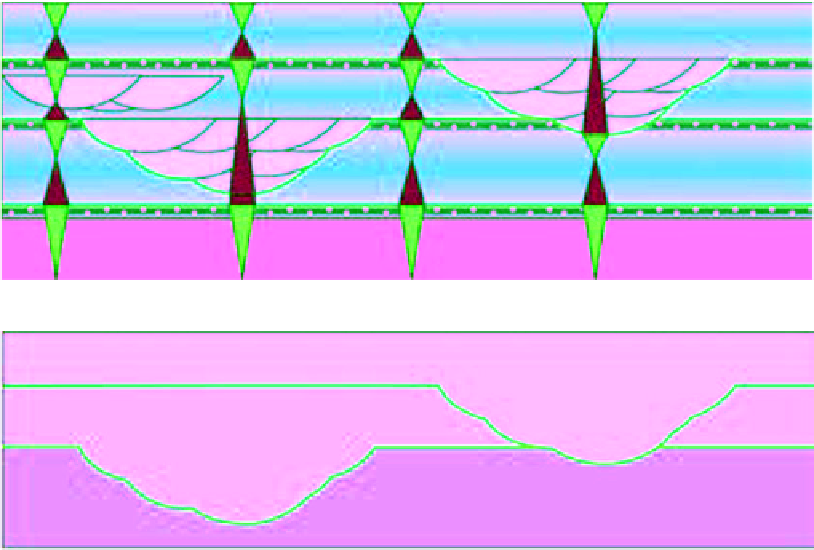Geoscience Reference
In-Depth Information
(A)
Well
I
Well
II
Well
III
Well
IV
Erosive channel bases
Mature palaeosol
Less mature palaeosol
and floodplain material
(B)
Zone 3
Zone 2
Zone 1
Fig. 11.
(A) Simplified sketch of multi-well correlation principles and; (B) resulting reservoir zonation. Note that in (A) i) three
full A/S cycles and 1 half A/S cycle are recognised (well 3) and ii) lateral correlation of the 2
nd
mature palaeosols is discontinu-
ous in the area of wells 2 and 4 due to channel belt incision (with an unconformity at the base) removing the first complete A/S
increasing-to-decreasing cycle in well 2 and the second complete A/S increasing-to-decreasing cycle in well 4.
resulting architecture within reservoir zones is
reflecting the A/S related stratigraphic development
of the reservoir more realistically than when using
lithostratigraphic correlation techniques because
the concept of time-equivalence is being taken into
account. Correlation lines are assumed to be quasi-
time lines that create envelopes containing geneti-
cally related depositional elements of approximately
equal ages (Fig. 11B). Connectivity between reservoir
zones in this case depends on local sand-to-sand
contacts across boundaries, not along boundaries as
in the case of lithostratigraphic zonation.
In this Statfjord Group example three different
hierarchical orders of A/S cyclicity are identified
(Fig. 12). The lowest order of cyclicity is marked by
the overall increase in A/S from the lower part of the
Statfjord Group into the lower Jurassic Dunlin Group.
This A/S increase is attributed to an overall base-
level rise and is represented by the transition from
terrestrial alluvial plain deposits (the Raude Fm)
through coastal plain deposits (Eiriksson Fm) and
transgressive reworking (Nansen Fm) into the marine
sediments of the Amundsen Fm. The Statfjord Group
thus comprises only the increasing A/S trend of this
lowest order cyclical development.
An intermediate, intra Statfjord Group-scale
A/S order of cyclicity is interpreted to be expressed
by the vertical development of facies and channel
belt stacking patterns. An upward increase in
channel belt connectivity for the sandstone bodies
of the Raude Fm, both vertically and laterally, is
interpreted to reflect a decrease in A/S up to the
base of the Eiriksson Fm (Fig. 12, A/S cycle 1).
Whilst the lower parts of the Raude Fm comprise
fewer, relatively stationary, channel belts, result-
ing in more isolated sandstone bodies and limited
connectivity, the upper Raude Fm shows a higher
degree of amalgamation and increased connectiv-
ity (but still relatively discontinuous sandstone
bodies compared to the Eiriksson Fm). An overall
upward increase in sand content associated with
decreasing channel-type facies variability is seen
also in this intermediate decreasing A/S half-
cycle. Palaeosol horizons within the Raude Fm

Search WWH ::

Custom Search